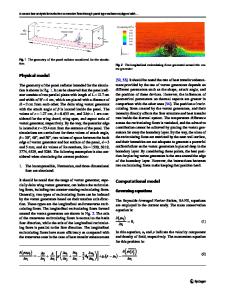Rheology model for turbulent suspension flow through a horizontal channel
- PDF / 815,750 Bytes
- 17 Pages / 595.32 x 841.92 pts (A4) Page_size
- 76 Downloads / 417 Views
DOI: 10.1134/S0869864320030075
Rheology model for turbulent suspension flow through a horizontal channel * A.A. Gavrilov and A.V. Shebelev Krasnoyarsk Department, Kutateladze Institute of Thermophysics SB RAS, Krasnoyarsk, Russia E-mail: [email protected] (Received October 29, 2019; revised November 25, 2019; accepted for publication February 10, 2020) A model was developed for solids-liquid flow with any solids concentrations. The model includes the two-phase flow equations for the entire flow. It includes also the rheology law and the particle transfer equation with account for interphase slipping. The statistical model of turbulence accounts for the turbulence modulation by particles. The model was tested on a problem about a steady state flow with suspended heavy particles in a horizontal pipe. Comparison with experimental data and other accurate simulations demonstrated that this new model is useful for predicting the features of turbulent suspension flows. The secondary flows in a pipe show three-layered structure of the two-phase flow. Keywords: suspension, turbulence, pipe flow, numerical simulation.
Introduction The solids-liquid flows are often observed in natural phenomena and technical apparatuses. The study of solid particles motion in a turbulent flow and the effect of carrier medium properties on the transport remains to be a complicated and challenging problem in multiphase fluid flow mechanics. In recent years, the approach of direct numerical simulation for study of a suspension flow with fluid dynamics for separate solid particles has found numerous applications [1]. However, this approach is too cumbersome for many engineering problems. The most useful models of solids-liquid turbulent flows are the class of two-fluid models. They describe the flow of carrier fluid and motion of particles ensemble (based on continuum presentation) and use the Reynolds-averaged and Favre-averaged equations. In developing of a turbulence model for a solids-liquid system, usually three levels of the description are taken: micro-scale, meso-scale, and macro-scale [2]. The micro-scale considers the motion of separate particles and liquid flow past those particles. The meso-scale is about averaged description of chaotic or pseudo-turbulent motion of particles with account for inter-particle interaction. The macro scale deals with laws of turbulent motion and entrainment of solids into pulse motion induced by turbulence vorticity. *
Research was performed according to the government order for ITP SB RAS (АААА-А17-117030910025-7).
A.A. Gavrilov and A.V. Shebelev, 2020
381
A.A. Gavrilov and A.V. Shebelev
The hydrodynamic interaction and direct collisions between particles cause the pseudoturbulent fluctuations and create the stress field; this should be accounted in simulation of flows with high particle concentrations. The stress field for solid phase (inter-particle interaction) can be calculated in the framework of the kinetic model for granular flow or using a phenomenological rheology-based model. The kinet
Data Loading...











